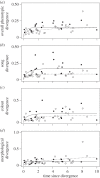Phenotypic divergence during speciation is inversely associated with differences in seasonal migration
- PMID: 26559951
- PMCID: PMC4685813
- DOI: 10.1098/rspb.2015.1921
Phenotypic divergence during speciation is inversely associated with differences in seasonal migration
Abstract
Differences in seasonal migration might promote reproductive isolation and differentiation by causing populations in migratory divides to arrive on the breeding grounds at different times and/or produce hybrids that take inferior migratory routes. We examined this question by quantifying divergence in song, colour, and morphology between sister pairs of North American migratory birds. We predicted that apparent rates of phenotypic differentiation would differ between pairs that do and do not form migratory divides. Consistent with this prediction, results from mixed effects models and Ornstein-Uhlenbeck models of evolution showed different rates of divergence between these groups; surprisingly, differentiation was greater among non-divide pairs. We interpret this finding as a result of variable rates of population blending and fusion between partially diverged forms. Ancient pairs of populations that subsequently fused are now observed as a single form, whereas those that did not fuse are observable as pairs and included in our study. We propose that fusion of two populations is more likely to occur when they have similar migratory routes and little other phenotypic differentiation that would cause reproductive isolation. By contrast, pairs with migratory divides are more likely to remain reproductively isolated, even when differing little in other phenotypic traits. These findings suggest that migratory differences may be one among several isolating barriers that prevent divergent populations from fusing and thereby increase the likelihood that they will continue differentiating as distinct species.
Keywords: comparative analysis; evolutionary rate; migratory divide; phenotypic divergence; seasonal migration; speciation.
© 2015 The Author(s).
Figures


Similar articles
-
The Role of Seasonal Migration in Population Divergence and Reproductive Isolation.Trends Ecol Evol. 2018 Mar;33(3):164-175. doi: 10.1016/j.tree.2017.11.008. Epub 2017 Dec 27. Trends Ecol Evol. 2018. PMID: 29289354 Review.
-
Isotopic variation across the Audubon's-myrtle warbler hybrid zone.J Evol Biol. 2014 Jun;27(6):1179-91. doi: 10.1111/jeb.12392. Epub 2014 Apr 29. J Evol Biol. 2014. PMID: 24779396
-
Speciation Associated with Shifts in Migratory Behavior in an Avian Radiation.Curr Biol. 2020 Apr 6;30(7):1312-1321.e6. doi: 10.1016/j.cub.2020.01.064. Epub 2020 Mar 19. Curr Biol. 2020. PMID: 32197080
-
Hybrid songbirds employ intermediate routes in a migratory divide.Ecol Lett. 2014 Oct;17(10):1211-8. doi: 10.1111/ele.12326. Epub 2014 Jul 16. Ecol Lett. 2014. PMID: 25040456
-
A long winter for the Red Queen: rethinking the evolution of seasonal migration.Biol Rev Camb Philos Soc. 2019 Jun;94(3):737-752. doi: 10.1111/brv.12476. Epub 2018 Nov 4. Biol Rev Camb Philos Soc. 2019. PMID: 30393938 Review.
Cited by
-
Integration of Genetic and Phenotypic Data in 48 Lineages of Philippine Birds Shows Heterogeneous Divergence Processes and Numerous Cryptic Species.PLoS One. 2016 Jul 21;11(7):e0159325. doi: 10.1371/journal.pone.0159325. eCollection 2016. PLoS One. 2016. PMID: 27442510 Free PMC article.
-
Seasonally migratory songbirds have different historic population size characteristics than resident relatives.Elife. 2025 May 12;12:RP90848. doi: 10.7554/eLife.90848. Elife. 2025. PMID: 40353828 Free PMC article.
-
Candidate genes for migration do not distinguish migratory and non-migratory birds.J Comp Physiol A Neuroethol Sens Neural Behav Physiol. 2017 Jul;203(6-7):383-397. doi: 10.1007/s00359-017-1184-6. Epub 2017 Jun 5. J Comp Physiol A Neuroethol Sens Neural Behav Physiol. 2017. PMID: 28585043 Free PMC article.
-
Comparative bioacoustics of multiple eastern versus western songbird pairs in North America reveals a gradient of song divergence.PLoS One. 2024 Dec 26;19(12):e0312706. doi: 10.1371/journal.pone.0312706. eCollection 2024. PLoS One. 2024. PMID: 39724219 Free PMC article.
-
Male courtship preference during seasonal sympatry may maintain population divergence.Ecol Evol. 2018 Nov 22;8(23):11833-11841. doi: 10.1002/ece3.4640. eCollection 2018 Dec. Ecol Evol. 2018. PMID: 30598780 Free PMC article.
References
-
- Winker K. 2010. On the origin of species through heteropatric differentiation: a review and a model of speciation in migratory animals. Ornithol. Monogr. 69, 1–30. (10.1525/om.2010.69.1.1) - DOI
-
- Webster MS, Marra PP. 2005. The importance of understanding migratory connectivity and seasonal interactions. In Birds of two worlds: the ecology and evolution of migration (eds Greenberg R, Marra PP), pp. 199–209. Baltimore, MD: Johns Hopkins University Press.
-
- Irwin DE, Irwin JH. 2005. Siberian migratory divides: the role of seasonal migration in speciation. In Birds of two worlds: the ecology and evolution of migration (eds Greenberg R, Marra PP), pp. 27–40. Baltimore, MD: Johns Hopkins University Press.
Publication types
MeSH terms
LinkOut - more resources
Full Text Sources
Other Literature Sources

